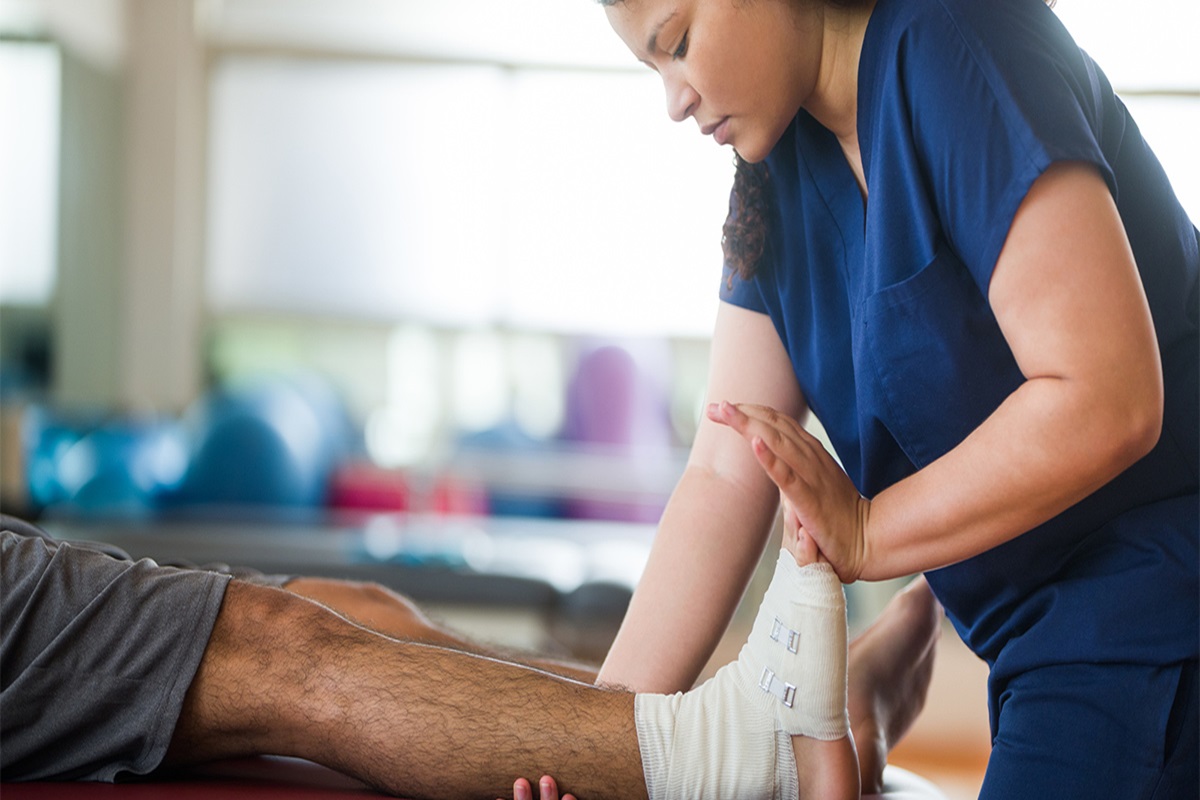Soft tissue injuries like sprains and strains can affect anyone—whether you’re hiking in the backcountry, lifting boxes at work, or simply stepping off a curb. Learning how to prevent sprains and strains is essential for maintaining your mobility, reducing downtime, and enhancing your quality of life. With the right knowledge and habits, you can build resilience into your daily movements and avoid common injury pitfalls.
Physical Therapy for Sprains and Strains provides a proven pathway to recovery and prevention, especially for individuals with a history of prior sprains or strains, balance limitations, or physically demanding lifestyles. With guidance from a trained physical therapist, you can address underlying issues such as limited joint flexibility, muscle weakness, and poor biomechanics.
Understanding Sprains and Strains
Sprains and strains are among the most frequent soft tissue injuries encountered in both clinical and everyday settings. These conditions primarily affect muscles, tendons, and ligaments, which play a crucial role in stabilizing and supporting joints throughout the body. Because they are so common, understanding how these injuries occur—and more importantly, how to prevent them—is foundational for long-term musculoskeletal health.
Sprains and strains are among the most common musculoskeletal injuries, yet many people misunderstand how they occur and how best to treat or prevent them. A clearer understanding of their differences and risk factors sets the foundation for smart injury prevention.
What Are Sprains and Strains and How Do They Differ?
Sprains involve stretched or torn ligaments—the tough bands of tissue connecting bones at a joint. Strains, on the other hand, affect muscles or tendons, which connect muscles to bones. While they may seem similar, understanding the difference is key when learning how to prevent sprains and strains. Common examples include an ankle sprain, knee sprain, or a pulled muscle in the hamstring. More severe cases like a grade III sprain, ligament tear, or muscle tear may require surgery or extended rehabilitation.
Most Common Causes in Everyday and Work Activities
In everyday life, injuries happen from twisting, falling, or improper lifting. At work, repetitive strain injury, awkward postures, or slippery or uneven surfaces increase the risk of injury. In sports, especially jumping sports, contact sports, or endurance sports, sudden movements and overuse are common culprits. Footwear also matters—ill-fitting or worn-out footwear can significantly compromise your stability.
The Hidden Cost of Untreated Soft Tissue Injuries
Ignoring a mild wrist sprain, neck sprain, or muscle strain can lead to persistent pain, joint instability, and limited range of motion. It may progress to chronic conditions that interfere with everyday tasks. Physical therapy for strain addresses not just the injury, but also the contributing factors. Through physical examination, history taking, and sometimes imaging tests, therapists create a customized care plan to accelerate healing and prevent recurrence.
Why Prevention Is Key for Long-Term Wellness
Being proactive about injury prevention not only saves you from downtime but also contributes to better physical fitness and long-term musculoskeletal health.
The Impact of Repeated Strain on Joints and Ligaments
Chronic stress on joints, tendons, and ligaments leads to tissue breakdown and injury. Repeated strain from daily tasks or training can result in overuse injuries, such as ACL tears, knee sprains, or tendonitis. Understanding how to prevent sprains and strains through strategic exercise and mobility training is critical.
Reducing Injury Risk Through Movement Awareness
Being aware of posture and alignment while lifting, walking, or even sitting reduces the strain on your body. This is especially true for people with balance disorders or those who work in physically demanding roles. Learning to identify early signs like numbness, tingling, or weakness, or hearing a pop or tear sensation, can prompt timely intervention.
The Role of Physical Therapy in Prevention and Recovery

Physical therapy for strain not only aids recovery but teaches preventive techniques such as dynamic stretching, taping techniques, proper lifting mechanics, and posture correction. Preventative care is especially useful for individuals who have a history of prior sprains or strains, are involved in contact sports, or have reduced muscle strength.
Preventing Sprains and Strains in the Workplace
With so many hours spent on the job, work-related injuries are not uncommon. Fortunately, small changes in setup and behavior can go a long way.
High-Risk Occupations and Repetitive Stress Factors
Sprains and strains have historically been one of the leading causes of injury across nearly every major occupational sector. In fact, data has shown that these types of injuries accounted for a significant portion of workplace health issues, with nearly one-third of all cases occurring in the trade, transportation, and utilities sectors, and another notable percentage in education and health services. Jobs that involve lifting, repetitive motion, or prolonged standing put workers at higher risk. Preventing sprains and strains in the workplace starts with identifying repetitive strain injury patterns and correcting them before they escalate. Warehouse employees, healthcare workers, and tradespeople often experience ankle sprains, wrist sprains, and neck tension from daily duties.
Jobs that involve lifting, repetitive motion, or prolonged standing put workers at higher risk. Preventing sprains and strains in the workplace starts with identifying repetitive strain injury patterns and correcting them before they escalate. Warehouse employees, healthcare workers, and tradespeople often experience ankle sprains, wrist sprains, and neck tension from daily duties.
Ergonomics and Workstation Setup for Injury Prevention
A poor desk setup can lead to neck sprain and back pain. Adjusting screen height, keyboard placement, and chair support can reduce strain. Wearing protective footwear in industrial settings or using supportive devices like wrist braces are great ways of preventing sprains and strains in the workplace.
Warm-Up, Microbreaks, and Postural Reset Techniques
Before physically demanding tasks, warm-up activities and dynamic stretching prepare the muscles and joints. Taking short microbreaks, especially in repetitive roles, allows time for postural reset and recovery. Regular stretching and mobility breaks throughout the day support joint integrity and reduce fatigue-related injury risk.
Daily Habits That Support Joint and Muscle Health
What you do daily has a direct impact on how well your joints and muscles function under stress. Developing consistent routines that prioritize mobility, strength, and recovery can dramatically reduce the risk of soft tissue injuries. This section breaks down practical, everyday strategies that reinforce your body’s resilience and keep sprains and strains at bay.
Stretching and Mobility Drills to Keep You Injury-Free
Regular stretching maintains flexibility and supports full range of motion in your joints. This is essential for preventing strains caused by stiffness or overuse. Include dynamic stretching before activities and static stretching afterward to maintain tissue health.
Strengthening Key Muscle Groups for Joint Stability
Strengthening exercises for your core, hips, shoulders, and legs creates a strong foundation. This improved muscle strength helps stabilize joints and absorb stress. Use brace or compression supports when needed, particularly during recovery from a grade III sprain or significant ligament tear.
Hydration, Sleep, and Recovery: The Often-Ignored Trio
Being well-hydrated improves tissue elasticity and nutrient transport. Adequate sleep supports tissue repair, and recovery allows the body to adapt to physical stress. Combined, they form the recovery triangle that underpins all prevention strategies. These basic self-care habits are a cornerstone of how to prevent sprains and strains sustainably.
Physical Therapy for Strain Prevention and Recovery
Partnering with a physical therapist helps address personal risk factors and recovery needs.
At Backcountry Physical Therapy, we believe that prevention is just as important as recovery. Whether you’re navigating the demands of a physically active lifestyle or recovering from a recent ankle sprain, muscle strain, or neck injury, our team of skilled physical therapists provides evidence-based care that’s tailored to your unique needs. Through a blend of hands-on treatment, functional movement training, and personalized education, we empower you with the tools and strategies needed to prevent future injuries and restore your performance. Ready to take the first step toward injury-free movement? Speak with a PT today and discover how proactive therapy can help you stay strong, mobile, and doing what you love.
Identifying Weak Links with a Physical Therapy Assessment
Therapists use detailed assessments, including physical examination and history taking, to uncover weak points in your posture, mobility, and strength. They may also use imaging tests to understand the grade of injury. This process is key in building a plan for physical therapy for strain that fits your body and lifestyle.
Manual Therapy and Neuromuscular Re-education
Soft tissue manipulation, manual therapy, and mobilization improve circulation and reduce muscle stiffness. Paired with neuromuscular re-education, these techniques help your body learn new, more efficient movement patterns. This approach is particularly effective for chronic issues such as neck or wrist sprain.
Tailored Exercise Programs Based on Your Lifestyle
From hikers to remote workers, everyone needs a unique plan. Your program may include mobility work, strength training, use of splints, or brace devices, all personalized for your daily needs. This approach ensures that Physical Therapy for Sprains and Strains is accessible and relevant to your lifestyle.
Neck Sprain Physical Therapy: What You Need to Know
The neck is a vulnerable area, especially with our tech-heavy lifestyles. Early and strategic intervention prevents long-term dysfunction.
How Physical Therapists Address Acute and Chronic Neck Strains
Neck sprain physical therapy targets inflammation, muscle tension, and underlying imbalances. Whether caused by a car accident, poor posture, or lifting injury, therapy may include ice, compression, rest, and eventually strength training to restore balance.
Postural Correction and Cervical Spine Stabilization
Improper posture contributes to cervical strain. Therapists teach postural corrections using exercises and environmental adjustments (e.g., monitor height). Neck sprain physical therapy strengthens neck and upper back muscles to support the spine and reduce recurrence.
Home Exercises and When to Seek Hands-On Therapy
Mild strains can often be managed at home with rest, ice, and stretching. However, if there is inability to move the joints, swelling, or worsening pain, it’s time to consult a physical therapist. Hands-on therapy ensures proper healing and provides strategies for how to prevent sprains and strains going forward.
Common Mistakes That Lead to Recurrent Strains and Sprains

Even with the best intentions, certain habits can unknowingly increase your risk of repeat injuries. Recognizing and correcting these mistakes is key to breaking the cycle of recurring sprains and strains. This section highlights common missteps and how small changes in routine can lead to better prevention outcomes.
Ignoring Early Warning Signs and Overtraining
Feeling numbness, pain, or tightness and continuing activity can worsen injuries. Ignoring these signs often leads to serious outcomes like a muscle tear or ligament tear. Applying the PRICE principle (Protection, Rest, Ice, Compression, Elevation) early can limit damage.
Poor Warm-Up or Cool-Down Routines
Skipping warm-up exercises or ending workouts abruptly can shock the body and raise your risk of injury. Incorporating dynamic stretching pre-activity and gentle movement after helps maintain muscle elasticity and joint health.
Lack of Cross-Training or Movement Variety
Engaging in only one type of movement pattern causes overuse. Adding yoga, swimming, or strength circuits improves adaptability and reduces the repetitive stress that leads to sprains and strains, particularly in athletes and active workers.
Conclusion
Injury prevention is not just for athletes—it’s for anyone who values movement, independence, and long-term health. By learning how to prevent sprains and strains, practicing good habits, and seeking guidance from a physical therapist, you’re investing in a future with fewer setbacks and more freedom. Whether you’re dealing with workplace demands or weekend adventures, the right strategy can keep you moving confidently.
FAQs
What are the 5 steps to treatment of sprains and strains?
The five essential steps are: rest, ice, compression, elevation, and physical therapy. These steps follow the RICE method and are part of the PRICE principle, with added focus on protection.
How do you best manage a sprain or strain?
Begin with the RICE method, then follow up with rehabilitation guided by a licensed therapist. Physical therapy for strain plays a key role in restoring mobility, strength, and preventing future episodes.
What precautions should be taken to prevent strains?
Practice good posture, wear proper fit shoes or protective gear, warm up properly, and stay consistent with mobility and strength exercises. Don’t ignore early signs of strain—seek physical therapy for sprains and strains if symptoms persist.



